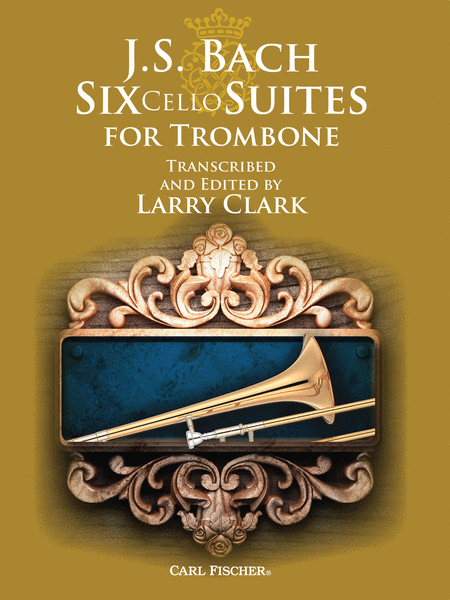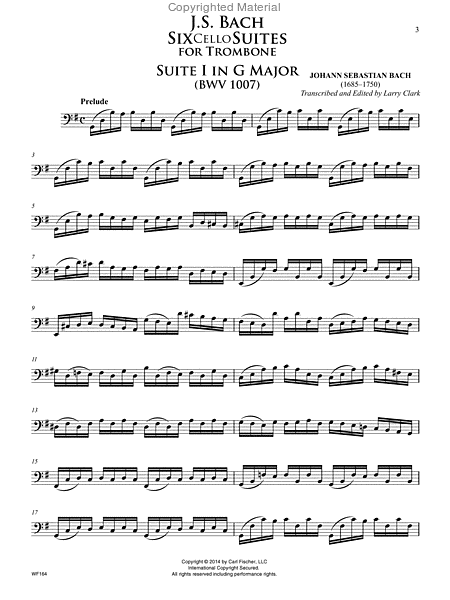J.S. Bach: Six Cello Suites for Trombone
Transcribed and Edited by Larry Clark
-
Ships in 1 to 2 weeks
Details
Description
SKU: CF.WF164
Transcribed and Edited by Larry Clark. Composed by Johann Sebastian Bach. Edited by Larry Clark. SWS. Back To School. Score. With Standard notation. 48 pages. Carl Fischer Music #WF164. Published by Carl Fischer Music (CF.WF164).ISBN 9780825896729. UPC: 798408096724. 9 x 12 inches. Transcribed by Larry Clark.
The Six Suites for Unaccompanied Celloare some of the frequently performed andrecognizable solo compositions ever written.This pieces have been meticulously transcribedfor the trombone, keeping the integrity of theoriginal Bach compositions while making themmore idiomatic. These pieces hold up in anysetting and are now available to a whole newgroup of instrumentalist to enjoy with thiswonderfully edited collection. A must have forany serious teacher or student of the trombone.
The six suites for unaccompanied cello by Johann SebastianBach have become some of the most popular and most frequentlyperformed pieces for any instrument. Because of the quality ofthese works, they have been transcribed for numerous instruments,including this new edition specifically for the trombone.Much about the origins of the suites is unknown, as an originalmanuscript in Bach’s own hand does not exist. The first record ofthe suites is from a manuscript in the hand of Bach’s second wifeAnna Magdalena. Two other manuscripts of the suites that havesurvived from Bach’s time: one by J. P. Kellner, the other by J. J. H.Westphal. Both were avid music collectors at the time. The difficultywith coming up with any kind of definitive collection of these pieceis that all three of the manuscripts seem to contain errors, making itdifficult to know exactly what were Bach’s intentions.Although enormously popular today, the suites were not allthat popular in Bach’s time. It wasn’t until the famous cellist PabloCasals discovered these pieces as a child and later recorded thesuites in 1936 that their popularity soared. There has always beencontroversy surrounding the performance interpretation of theseworks, since much of Casals’ interpretation was founded on a highlyromanticized flare. For every cellist that has played the suites, thereare differing ways to perform these works. To date there are overeighty editions of the suites, just for the cello.The suites were brought to my attention by my teacher when Iwas a trombonist in college. I studied these pieces from an existingedition for cello. In this new edition, specifically for the trombone,I have worked to keep the integrity of the original suites intact asmuch as possible, but also to add phrase markings and articulationsto make the pieces idiomatic for the instrument.To begin, I went back to the original Anna Magdalenamanuscript as the foundation. From there I added or changedphrase markings that would help a trombonist to play these suitesas they would sound on the cello. Inevitably, anytime you take ona project like this, your own opinion and performance sensibilitiescome in to play. I suggest that when you work on these pieces youalter the markings to fit your sensibilities, just as Casals did or asany other person that has ever played these works has done. I havenot included any dynamic indications, as those are up for debateas well. Each person who studies these works should make theirown musical decisions based on their own discovery, research andmusical sensibilities.As part of the editing of the suites I added in cue-sized notes in asmusical a way as possible, so that a person without an F-attachmenttrombone can still work with these pieces. Also, note that I haveretained many of the double stops from the original cello suites, asthey help the performer better to understand the implied harmoniesof the pieces. I believe that many of them can be performed in anarpeggiated fashion on the trombone to bring about a more completeperformance.It is my hope that this new edition will help to bring theseincredibly rich pieces to many more instrumentalist who otherwisewould not get the chance to play them without this book. I hopeyou enjoy Bach’s works as much as I have enjoyed preparing thisedition.


 Share
Share